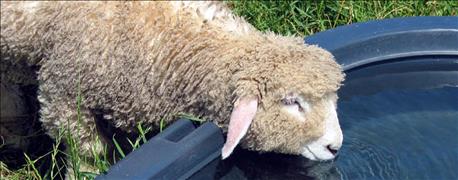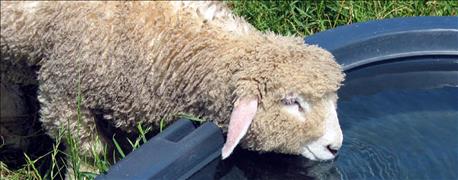December 14, 2016

Water is certainly an essential nutrient for life, and all animals need water to survive and thrive. But when do sheep need supplemental fluid water from a water source? This question has important implications for how sheep are managed, especially during winter.
The following conditions determine how much supplemental, fluid water is needed by sheep:
• productive state of the animal, as in growth, pregnancy or lactation
• environmental temperature and humidity
• water content of the feed consumed
• amount of consumable, frozen water present, such as soft snow
 WATER SOURCE: The water content of feed is a critical determinant of whether or not sheep need supplemental fluid water.
WATER SOURCE: The water content of feed is a critical determinant of whether or not sheep need supplemental fluid water.
These factors together determine the conditions under which sheep need supplemental fluid water. There are some modifying conditions within these major factors to consider as well.
Productive state of the animal
Mature ewes and lambs at maintenance (the level of nutrition in which they neither gain nor lose weight) have lower water needs than the other productive states. Growing animals need more, while heavily pregnant animals require even more water. The water requirements of early and midpregnancy are just slightly more than those at maintenance, until they increase rapidly during the last month of pregnancy.
The extent of this increase in water need throughout the stages of pregnancy is also dependent on how many lambs the ewe is carrying. Ewes carrying singles have much lower water requirements than those carrying triplets during late pregnancy.
Finally, lactation has a higher water demand than the other stages. The specific water needs of lactation are dependent on the extent of the metabolic “burden” of lactation, which in turn is dependent on the stage of lactation and how many lambs the ewe is nursing. Sheep in early lactation (first 30 days following birth) have higher requirements than those in late lactation (greater than 30 days in milk). Ewes nursing singles have much lower water requirements than those nursing multiples. As a general rule, ewes carrying twins or greater during late pregnancy, and nearly all ewes in lactation, will require supplemental fluid water even in cold weather.
Environmental conditions
The water needs of all livestock drop approximately 50% between 72 and 36 degrees F. Therefore, the water needs of sheep, regardless of productive state, are much lower during winter, and in many winter grazing situations, low enough that these needs can be entirely met with water from grazing forage or soft snow. In grazing situations, relative humidity also plays a factor. During fall and spring grazing, as the temperature drops and the air is still relatively humid, there is abundant dew formation on grass, which can provide a lot of water to grazing animals. Sheep often ignore water troughs starting mid-September as the temperature drops and the dew is heavy. The same situation holds for early spring after freezing conditions stop, but before temperatures rise significantly, which can occur in mid-May in many parts of Michigan.
Water content of feed
The water content of feed is a critical determinant of whether or not sheep need supplemental fluid water. In indoor housing situations with dry feeds, all sheep will need access to a fluid water source, regardless of temperature. In indoor housing situations with silage feeding, this may not be the case, but it is highly advised to provide water when feeding indoors.
In grazing, however, the situation changes. Providing supplemental fluid water can be difficult to do, especially as the temperature drops below freezing. During cold weather, the water content of most grazing forage will provide all the water that mature, nonlactating sheep need.
For those grazing nonlactating ewes before late pregnancy on cover crops, such as brassicas, and small grain where forage water content is usually greater than 80%, or in situations of grazing stockpiled perennial pasture where forage water content is usually greater than 70%, during fall and winter, there is no need for fluid water access. This should come as a relief to those contemplating fall and winter grazing and thinking they need a portable, heated stock tank on pasture or some type of frost-free watering system on pasture.
In addition, it should confirm the observations of seasoned graziers who already know that if you provide stock tanks filled with fluid water, they will rarely be visited under these conditions. Based on these examples, it should become clear that it is important to know the forage water content of pasture when grazing during the fall and winter. Those grazing cornstalks or other relatively dry crop residues may have issues providing sufficient water to their sheep without providing a fluid water source. This situation can occur during late fall before snow falls. Once snow accumulates, most sheep — excluding lactating and late-pregnant ewes — will be able to obtain sufficient water to meet their needs through snow consumption.
Ehrhardt is an Extension specialist of small ruminants at Michigan State University Extension.
You May Also Like




